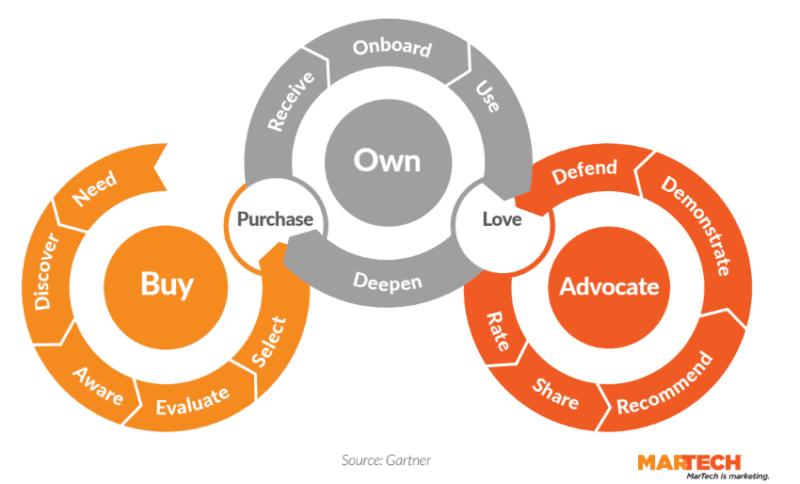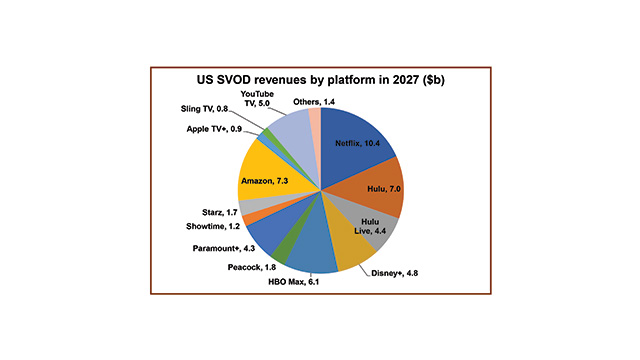The disruptions brought about by the COVID-19 pandemic have resulted in businesses renewing their appreciation for existing customers, as well as customer journey orchestration (CJO) tools that help guide and enhance the journey.
Marketers are especially focused on the latter stages of the journey, with an eye toward fostering relationships that yield recurring revenue. CJO tools are designed to include touchpoints like interactions with customer success representatives, who often deliver the experience supporting those long-term relationships.
Read next: What is customer journey analytics?
The end-to-end customer journey
More broadly, businesses are recognizing that adequate customer experiences are becoming table stakes, making it more difficult to achieve differentiation that drives business success. Yet, few marketers are successfully satisfying customers in all phases of their relationship.
A full thirty-one percent of marketers surveyed by Gartner said they end their journey maps with the purchase, the lead acquisition, the initial transaction or the delivery of the product or service.
“A journey map that focuses merely on the purchase funnel, and not the entire end-to-end customer journey, is not a CX journey map,” said Augie Ray, VP and analyst with Gartner’s Marketing practice. “Those sorts of journey maps may assist with efforts to build awareness, inbound traffic and acquisition, but they cannot uncover the opportunities that influence customer satisfaction, loyalty and long-term advocacy.”

Raising the stakes with the customer journey during the COVID-19 pandemic
The COVID-19 pandemic raised the stakes. Before the pandemic, most customers — both consumers and business buyers — had already interacted online for many years, which means they have a bank of experiences to draw upon when evaluating new interactions.
Get MarTech! Daily. Free. In your inbox.
They know what an online check-out should be like; they have researched business purchases; they have gone through the process of signing up for a new bank account online, etc. So merely adequate experiences aren’t enough to differentiate one brand from another.
During the pandemic, more people became accustomed to conveniences like buy-online pick-up-in-store or curbside deliveries from restaurants and retail locations. Eighty-eight percent of customers expect companies to accelerate digital initiatives as a result of COVID, with 69% of those surveyed expecting new ways to get existing products and services and 54% believing businesses should offer entirely new products and services, Salesforce found in the “State of the Connected Customer” report.
Forrester Research calls it the “most frenzied phase of innovation” consumer-facing businesses have ever experienced, in a report aptly titled “Vast, Fast and Relentless,” warning brands that “customers won’t let you rest anytime soon.”

To break through and engender customer loyalty, businesses must develop a deeper understanding of their customers’ journeys, as well as the motivations and values that drive them to engage. Critically, the customer journey doesn’t end with the purchase, so users’ experience with products and customer service interactions affect the lifetime value of that customer.
It’s these later stages that marketers are focusing on when they shift to existing customers during the pandemic and beyond.
Download the full MarTech Intelligence Report: Enterprise Customer Journey Orchestration Platforms: A Marketer’s Guide
Customer journey analytics: A snapshot
What it is. Customer journey analytics software lets marketers connect real-time data points from across channels, touchpoints and systems, allowing users to gain insights into the customer journey over time. This allows marketers to explore the customer journey using data.
Why it’s hot today. Businesses know they need to be customer-focused in each aspect of their marketing operations. As a first step, brands need to understand how consumers are finding them. Whether it be via search, advertisement, or word of mouth, the medium used will set the trajectory for the rest of their journey.
Meanwhile, the average person uses many devices to access the internet, and Cisco forecasts that the number of devices connected to IP networks will increase to more than three times the global population by 2023. With so many devices, people shift back and forth depending on the task at hand and their current environment. Consumers and business buyers turn to an average of nine channels to browse product inventory, look for advice, and make purchases.
Capturing their interactions post-discovery, such as communication with a call center or visit to a retail outlet, helps brands see which of their assets are helping them along their path. What’s more, brands need to know what those who convert do post-purchase–this information helps companies win repeat business and encourage customer advocacy. Customer journey analytics tools do just that.
What the tools do. The majority of vendors offer one or more of the following capabilities to give marketers an understanding of the customer journey: data gathering from a wide variety of channels and touchpoints; analysis using artificial intelligence and machine learning, and customer journey visualization.
Many vendors also offer customer journey orchestration (CJO) capabilities, which allow users to act upon the insights and actually deliver the next step in the customer journey in real-time.
Why we care. Customers expect to have consistent experiences at each of these touchpoints. They want personalization, a trend that continues to grow. Tools like customer journey analytics software give brands the ability to gain insights from their audience and act on them.
Dig Deeper: What is customer journey analytics and how are these tools helping marketers?






































































![Local SEO Ranking Factors [Infographic] Local SEO Ranking Factors [Infographic]](https://www.socialmediatoday.com/imgproxy/Rf1V9KKdNQJbfVNLp68ZEqI9zdZ7RXLw9EHQMGyVbdA/g:ce/rs:fill:700:17601:0/bG9jYWw6Ly8vZGl2ZWltYWdlL2xvY2FsX3Nlb19yYW5raW5nX2ZhY3RvcnMxLnBuZw.png)
